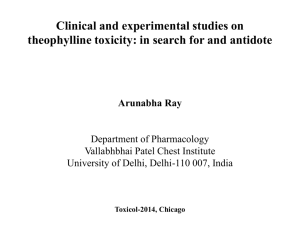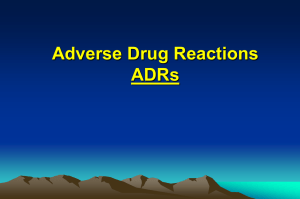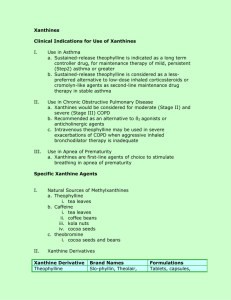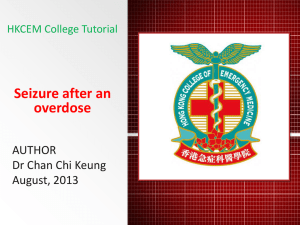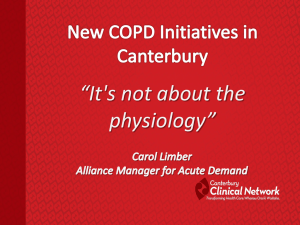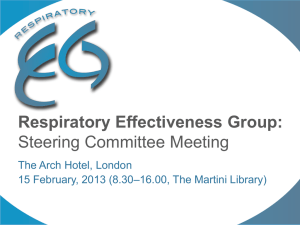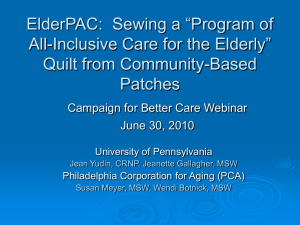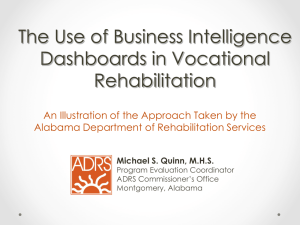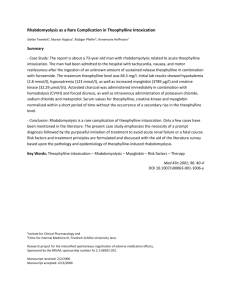Pharmacovigilance Studies in Hospital
advertisement
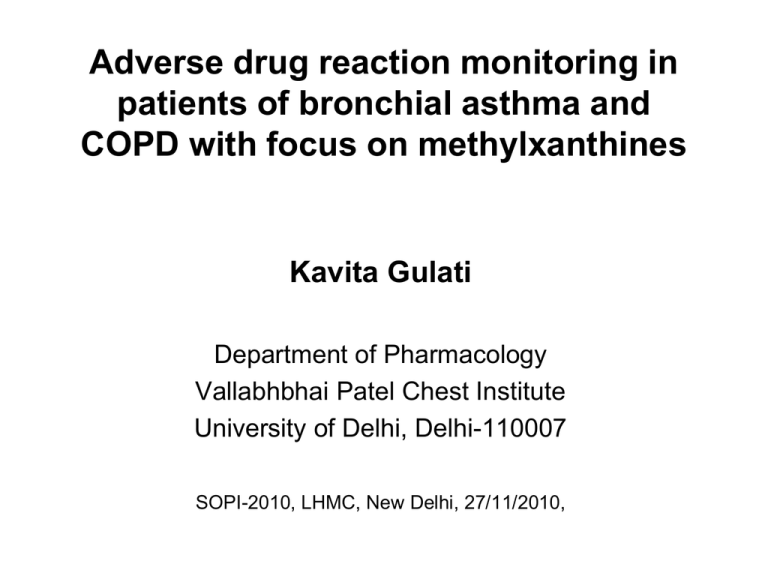
Adverse drug reaction monitoring in patients of bronchial asthma and COPD with focus on methylxanthines Kavita Gulati Department of Pharmacology Vallabhbhai Patel Chest Institute University of Delhi, Delhi-110007 SOPI-2010, LHMC, New Delhi, 27/11/2010, Adverse Drug Reactions • A response to a drug that is noxious and unintended and that occurs at doses used in humans for prophylaxis, diagnosis, or therapy of disease, or for the modification of physiologic function • Excludes therapeutic failures, overdose, drug abuse, non-compliance, and medication errors Adverse Drug Reactions • ADR contribute significantly to the morbidity and mortality and increased health costs • Over 2 million serious ADRs per year, responsible for 5% of hospital admissions, 1,00,000 deaths yearly • ADRs :leading cause of morbidity, ahead of lung disease, diabetes, AIDS, Trauma Need of ADR monitoring • India : 4th largest producer of the pharmaceuticals in the world • Drugs prescribed (sometimes indiscriminately and irrationally) in various combinations (polypharmacy) • Large sections of population exposed • ADR contribute significantly to the morbidity and mortality and increased health costs • Clinical trial data not sufficient • A dire need for a scientific/systematic and uniform method to monitor ADRs Pharmacovigilance methods • Spontaneous reports (most commonly) • PEM (prescription event monitoring) • Observational Studies(Case Control and Cohort Studies) Spontaneous reporting • Unsolicited communication by health care professionals or consumers to a company, regulatory authority or any other organization (WHO, Regional Centers) that describes one or more Adverse Drug Reactions in patient who was given one or more medicinal products • It does not derive from a study or any organized data collection scheme Causality assessment Hutchison defined causality assessment as a “method for eliciting a state of information about a particular drug-event connection as input and delivering as output a degree of belief about the truth of the proposition that the drug caused the event to occur” Causality Assessment scales • Naranjo’s scale • WHO causality assessment scale Causality Assessment • • • • • • • Prior reports of reaction Temporal relationship De-challenge Re-challenge Dose-response relationship Alternative etiologies Past history of reaction to same or similar medication T o a sses s th e ad verse drug re ac ti o n, plea se an sw er th e f o llow in g q ue stion na ir e an d gi v e th e p er tin e nt sc ore. 1. 2. 3. Naranjo ADR Probability Scale 4. 5. 6. 7. 8. Naranjo CA. Clin Pharmacol Ther 1981;30:239-45 9. 10 . A re th e re p rev ious conc lu si ve repo rt s on th is re ac ti on? D id th e adve rs e ev e n t appe a r a ft er t he su spec ted d rug wa s ad mi n ist er e d? D id th e adve rs e reac ti on im prove when t he d rug wa s d is con ti nued o r a sp e cifi c an tagon ist wa s ad mi n is te re d? D id th e adve rs e reac ti on s app e ar when the d rug wa s read mi n is te re d? A re th e re a lt erna ti ve c ause s (o the r than t he d rug) t ha t cou ld on the ir o w n have cau sed the re a cti on? D id th e reac ti on re a ppea r when a p lacebo wa s g iven ? Wa s the d rug de tec te d in th e b lood (or o the r fl u ids ) in concen tr ati ons known to be tox ic? Wa s the r eac ti on m o re sev e re when the dos e wa s inc rea sed , o r less sev e re when t he dos e wa s d e cr e ased ? D id th e pa ti en t have a si m il ar re a cti on to the sa m e or simil ar d rugs i n any prev iou s expo sure ? Wa s the adve rse even t con fi rm ed by a ny ob jec ti ve ev idence ? Ye s +1 No 0 Do No t Know 0 S co re ____ +2 -1 0 ____ +1 0 0 ____ +2 -1 0 ____ -1 +2 0 ____ -1 +1 0 ____ +1 0 0 ____ +1 0 0 ____ +1 0 0 ____ +1 0 0 ____ T ot al S co re ____ T o tal Sco re A DR P robab ilit y C la ssifi ca tion 9 5 -8 1 -4 0 H igh ly Pr obab le P rob a b le P os si b le Doub tf u l • Respiratory diseases • Respiratory diseases : a major cause of hospital admissions • Obstructive airway disease (Bronchial Asthma and COPD) affect 5-7% population in industrialized countries • Several factors (allergy and smoking) contribute to their genesis • Optimization and rationalization of drug therapy : key to effective management Respiratory disease…. • Drug therapy involves polypharmacy • Multiple routes of drug administration – sometimes in the same individual • Complex drug – drug interactions always a possibility • Long term drug usage compounds the problem • Drugs with narrow therapeutic indices ADR monitoring in Asthma and COPD • 120 patients of bronchial asthma and COPD were selected from the VPCI OPD • Ethical clearance and GCP guidelines • Standard inclusion/exclusion criteria • Diagnosed by clinical features and PFT findings • ADR profile was recorded as per National Pharmacovigilance Programme proforma • Dechallenge and rechallenge were done wherever appropriate • Causality Assessment was done by using the Naranjo`s scale SEX-WISE DISTRIBUTION OF MALES AND FEMALES ENROLLED IN THE STUDY FEMALES 7% MALES 93% MALE FEMALES GENERAL PROFILE OF DRUG TREATMENT AND ADVERSE EFFECTS IN COPD Drug Given No. of Patient Receiving the Drug No. of Patient Complaining of ADR Percentage Inhaled Steroids 53 30 56% Inhaled Anticholinergics 44 10 22.7% Oral Theophylline 43 20 46.5% Oral Steroids 14 3 21.4% Antibiotics (Oral) 14 3 21.7% Short Acting 2 agonist 55 3 5% N-acetyl cysteine 2 2 100% PERCENTAGE OF OUTPATIENTS RECEIVING DIFFERENT DRUGS FOR TREATMENT OF COPD 100% 90% 80% % of Patients 70% 60% 50% 40% 30% 20% 10% 0% Inhaled Stero ids +LA b2 agonist Inhaled A nticholinergics Oral Theo phylline Oral Stero ids A ntibio tics (Oral) Sho rt A cting b2 A gonist NA cetylcysteine PERCENTAGE OF OUTPATIENTS COMPLAINING OF ADR WITH DIFFERENT DRUGS USED FOR TREATMENT OF COPD • 100% 90% Percentage of Patients 80% 70% 60% 50% 40% 30% 20% 10% 0% Inhaled Stero ids Inhaled A nticholinergics Patents Receiving the Drug Oral Theo phylline Oral Stero ids A ntibio tics (Oral) Sho rt A cting b2 N-Acetylcysteine A gonist Percentage of Patients Complaining of ADR due to the Drug ADR profile with respiratory drugs Drugs Br. Asthma COPD Profile Inhaled steroids 54/60 (90%) 30/60 (50%) Sore throat,dysguesia, hoarseness,gloss itis, others Inhaled anticholinergics 25/40 (62%) 10/44 (23%) Dry mouth,thirst, urinary difficulty Inhaled beta-2 agonists(SA) 15/35 (43%) 3/55 (5%) Hand tremors Oral steroids 28/32 (87%) 3/14 (21%) Wt. gain, acne, cramps, mood changes Oral theophylline 14/20 (70%) 20/43 (46%) Anxiety, dyspepsia, mus. spasm, paresthesia, etc Results • Most ADRs : mild to moderate, few were intolerable and required dose reduction ( oral steroid and theophylline) • 75% of patients complained of one or other ADR • 23 % of COPD patients and 53 % of bronchial asthma patients required oral steroids • Oral steroids were associated with incidence of ADRs 21% (in COPD) and 87% (in br. asthma) • 84 of total patients received inhaled anticholinergics out of which ADRs were noted in 41% patients Theophylline • Bronchodilators and corticosteroids are the mainstay in the treatment of OADs • Recently a resurgence in the interest in theophylline due to anti-inflammatory and immunomodulatory effects reported • Low doses (lower than those needed to induce bronchodilation) exert beneficial effects • Judicious use could be of benefit in OAD in developing countries (reduces dose of steroids and a pharmacoeconomically viable drug Prescription monitoring in obstructive airway disease (theophylline) Prescriptions Total No. With theophylline % All patients 120 63 52.6 Br. Asthma 60 20 33.3 COPD 60 43 71.6 Prescription audit in obstructive airway disease (theophylline) 100 90 80 70 60 Total Theoph 50 40 30 20 10 0 All Rx Asthma COPD ADR incidence with theophylline Patients Received Showed Theophylline ADRs % Br. Asthma 20 14 70 COPD 43 20 46.5 Total 63 34 53.9 ADVERSE EFFECT PROFILE IN COPD PATIENTS WITH ORAL THEOPHYLLINE ADR No. of Patients Percentage Dyspepsia 13 65% Anxiety 12 60% Spasm of Muscles 6 30% Insomnia 2 10% Dizziness 2 10% Theophylline Withdrawal Induced Constipation 1 5% Paraesthesia 2 10% Others 1 5% PERCENTAGE OF DIFFERENT ADRs WITH ORAL THEOPHYLLINE IN COPD PATIENTS 70% 60% 50% 40% 30% 20% 10% 0% Dyspepsia Anxiety, Palpitation Spasm of M uscles Insomnia Vertigo, Dizziness Theophylline Paraesthesia Withdrawal Constipation Percentage of Patients Complaining of ADR Others Adverse effect profile in patients with oral theophylline in bronchial asthma -----------------------------------------------------------------------------ADR No. of Patients % -----------------------------------------------------------------------------Dyspepsia 09 45 Anxiety 10 50 Spasm of Muscles 07 35 Insomnia 08 40 Paresthesia 04 20 Dizziness 03 15 Others 02 10 ------------------------------------------------------------------------------------ Incidence of ADRs after theophylline in patients of Bronchial Asthma 50 45 40 35 30 25 20 15 10 5 0 Dys Anx Ms sp Ins Par Dizz Oth Causality assessment of ADRs due to oral theophylline using the Naranjo’s scale Oral Theophyllin Highly Probable (9) Probable (5-8) Spasm of muscle of calves (most commonly) sternocleido mastoid, intercoastal muscles (1)Dyspepsia (2)Insomnia (3) Anxiety (4)Dizziness (5)Withdrawal induced Constipation (6)Paraesthesia (7)Colicky Pain (8)Diuresis Possible (1-4) Doubtful (0) A comparative study… • A prospective, open label, randomized, parallel design study was carried out to compare the efficacy and safety of two methylxanthines, namely theophylline and doxofylline in patients of bronchial asthma and COPD • A total of 60 patients, 30 each of bronchial asthma and COPD were enrolled for the study as per the laid down inclusion and exclusion criteria • Each group of 30 patients received standard treatment for asthma and COPD Comparison of ADRs after theophylline and doxofylline in bronchial asthma anxiety Muscle spasm Dizziness Sore throat No ADRs insomnia No ADR Comparison of ADRs after theophylline and doxofylline in COPD anxiety Muscle spasm insomnia anxiety Dry mouth Tremors Gastritis Nausea No ADR No ADRs Summary • Doxofylline was more therapeutically effective than theophylline in COPD • ADR profiles of theophylline and doxofylline included dyspepsia, anxiety, muscle spasm, tremors, dizziness, and headache • Doxofylline treated group was associated with lesser frequency of ADRs as compared to the theophylline group • Such focussed studies will be helpful in rationalizing drug therapy in OAD Acknowledgements • • • • • Dr. V K Vijayan Prof. A Ray Dr. Neeraj Tyagi Dr. Gaurav Vishnoi Dr. Dushyant Lal

